

The flagellation in front of the Gospel DoorsAccording to the semi-official guidebook, "Christ's solitude during the flagellation is depicted by his position: this figure is placed between the denial of Peter and the betrayal of Judas. it is the most important sculpture on the lower level and is therefore five metres high and sculpted in travertine marble" (The Expiatory Temple 90). The cane on the base alludes to the soldiers' ridicule when giving him a cane instead of a scepter. The guide suggests that the column is in four parts symbolizing the four arms of the cross. | ||
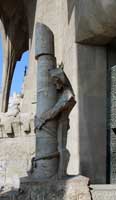
|

|

|
The Middle LevelThis level represents the path to the crucifixion showing Veronica in the center with the veil on which Jesus' face appears. Oddly, her face is blank. At the same time, Subirachs alludes to Gaudí and his works. Note the figures of the soldiers. See, for example the chimneys in Casa Milà. The profile of the evangelist on the far left is that as well of the honored architect. | ||
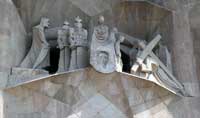
|

|
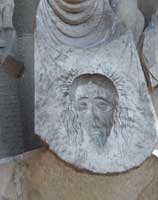
|
Longinus and the Three Marys and Simon the CyreneLonginus was the soldier who speared Jesus in the side but later converted to Christianity while Simon helped the fallen Jesus carry the cross. |
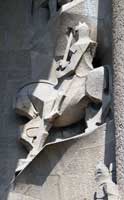
|
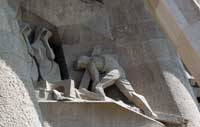
|
The Upper Level | ||

|
Soldiers playing dice |
|
View of the Middle and Upper levels with the path to the crucifixion and at the top the actual crucifixionThe depiction of the crucifixion is traditional with Mary Magdalene kneeling and John comforting the Virgin Mary, also on the left side. The moon on the top right indicates it is a night scene and the scull at the bottom signifies Golgotha. The bronze veil is at the very top representing the separation between the sacred place in the Temple of Jerusalem and the rest of the rooms. | ||
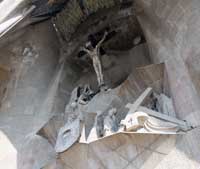
|
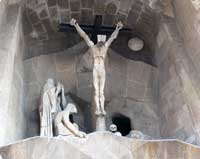
|
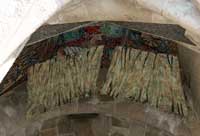
|
 Go to Gaudí Index.
Go to Gaudí Index.
 Click here to return to index of art historical sites.
Click here to return to index of art historical sites.
 Click here to return to index of artists and architects.
Click here to return to index of artists and architects.
 Click here to return to chronological index.
Click here to return to chronological index.
 Click here to see the home page of Bluffton College.
Click here to see the home page of Bluffton College.

